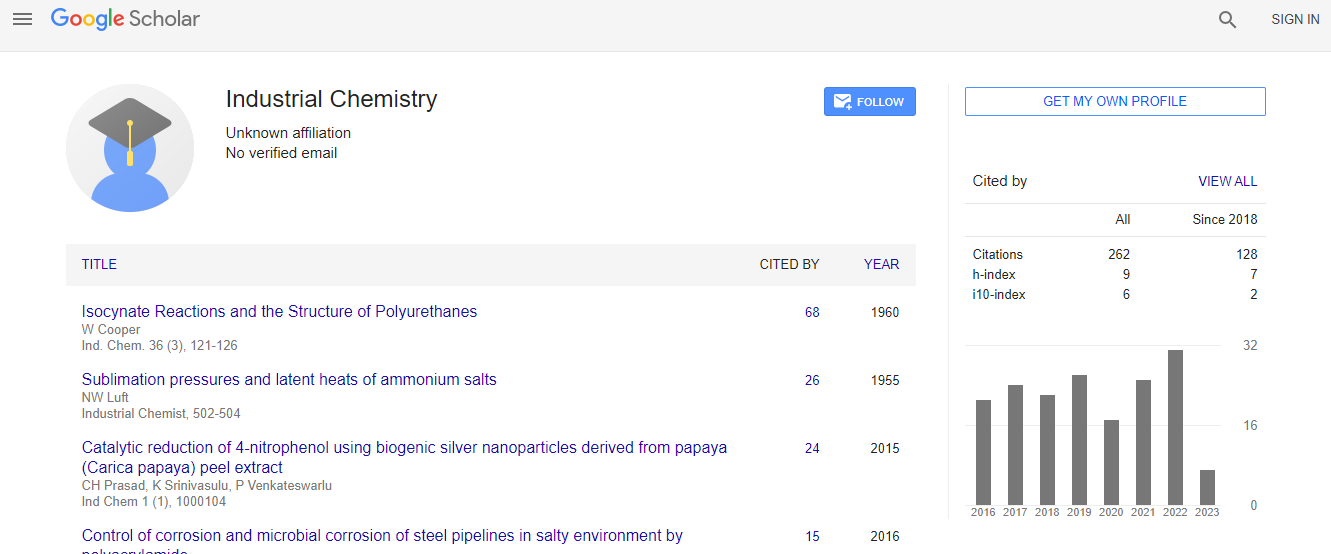Our Group organises 3000+ Global Conferenceseries Events every year across USA, Europe & Asia with support from 1000 more scientific Societies and Publishes 700+ Open Access Journals which contains over 50000 eminent personalities, reputed scientists as editorial board members.
Open Access Journals gaining more Readers and Citations
700 Journals and 15,000,000 Readers Each Journal is getting 25,000+ Readers
Google Scholar citation report
Citations : 262
Industrial Chemistry received 262 citations as per Google Scholar report
Indexed In
- Index Copernicus
- Google Scholar
- RefSeek
- Directory of Research Journal Indexing (DRJI)
- Hamdard University
- EBSCO A-Z
- OCLC- WorldCat
- Scholarsteer
- Geneva Foundation for Medical Education and Research
- Euro Pub
Useful Links
Recommended Journals
Related Subjects
Share This Page
Crystalline/amorphous low energy bandgap TiO2 materials prepared in solution and their industrial applications
2nd World Conference on Industrial Chemistry and Water Treatment
Hyoyoung Lee
Sungkyunkwan University, South Korea
Keynote: Ind Chem
Abstract
Recently, surface-disordered TiO2, referred to as black TiO2, which can absorb both visible and near-infrared solar light that has triggered an explosion of interest in many important applications. Here, we demonstrate a selective reduction of commercialized degussa P-25 TiO2 nanoparticles using simple room-temperature solution processing, which maintains the unique three-phase interfaces composed of ordered white-anatase and disordered black-rutile with open structures for easy electrolyte access. The strong reducing agent in superbase, which consists of lithium ion ethylenediamine (Li-EDA), can disorder only the white-rutile phase of P-25. Single P-25 TiO2 nanoparticles with this engineered surface made immediate contact with the electrolyte. This contact is called white-black-electrolyte three-phase interfaces and can not only efficiently internally separate electrons/holes through type-II bandgap alignment but also induce a strong hydrogen (H2) evolution surface reaction. The white-black-electrolyte three-phase interfaces exhibited outstanding H2 production rates of 13.89 mmol/h/g using 0.5 wt.% Pt (co-catalyst) and 3.46 mmol/h/g without using any co-catalyst. These values are the highest recorded in the world to date. In addition, our newly developed crystalline/amorphous reduced TiO2 (rTiO2) that has low energy bandgap can effectively generate reactive oxygen species (ROS) under solar light and successfully remove a bloom of algae. Only reduced TiO2 materials can generate ROS under solar light, which was confirmed by electron spin resonance. Among the three different types of Li-EDA treated TiO2 (anatase, rutile and both phased TiO2), the both phased rTiO2 showed the best performance to produce ROS. The generated ROS effectively removed the common green algae Chlamydomonas. This is the first report on algae degradation under solar light, proving the feasibility of commercially available products for disinfection. Finally, we like to introduce transition metal chalcogenide materials for the hydrogen evolution reaction and energy storage with graphene flakes.Biography
Hyoyoung Lee has received his PhD degree at Department of Chemistry, University of Mississippi (USA) in 1997. He did his Post-doctorate at North Carolina State University, USA, for 2 years. He has worked at Electronics and Telecommunications Research Institute from 2000 to 2009 as a Team Leader. He moved to Sungkyunkwan University and has served as a Full Professor at Departmet of Chemistry, lecturing Organic Chemistry. He has served as a Director of National Creative Research Initiatives (NCRI), Center of Smart Molecular Memory from 2006 to 2015. Currently, he has serving as an Associate Director of Centre for Integrated Nanostructure Physics (CINAP), Institute of Basic Science (IBS) from November 2015. His current research area is on organic semiconducting materials including low bandgap TiO2 and devices including molecular/organic memory, OLED, OTFT, sensors, Energy harvesting and storage, graphene oxide, reduced graphene oxide and 2D transition metal chalcogenide (TMC). He has written more than 120 journal articles with top-tier journals.
Email: hyoyoung@skku.edu

 Spanish
Spanish  Chinese
Chinese  Russian
Russian  German
German  French
French  Japanese
Japanese  Portuguese
Portuguese  Hindi
Hindi 